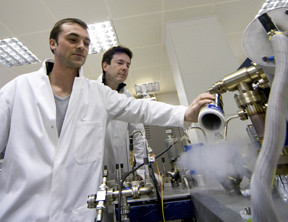|
News Notes
Geochemistry
Earth soaks up seawater
 Geologists
have long thought that seawater does not travel very far through Earth’s
interior, stopped by an invisible heat and pressure barrier that recycles
it back up through the crust. A new study, however, is challenging that
notion, saying that traces of seawater exist deep inside the planet.
Geologists
have long thought that seawater does not travel very far through Earth’s
interior, stopped by an invisible heat and pressure barrier that recycles
it back up through the crust. A new study, however, is challenging that
notion, saying that traces of seawater exist deep inside the planet.
Isotope geochemists Greg Holland (left) and Chris Ballentine prepare liquid nitrogen cold traps to extract noble gases from a mixed well gas sample. The researchers analyzed the gases and determined that the sample contained a largely marine “fingerprint,” which may indicate large-scale seawater recycling through Earth’s interior. Image is courtesy of the University of Manchester.
All water on Earth — whether on the surface or in the interior — originates from the accretionary processes that created the planet 4.5 billion years ago. The water that circulates through rain, rivers and oceans on the surface, however, is geochemically distinct from water inside the mantle, says Greg Holland, a geochemist at the University of Manchester in the United Kingdom. That distinction is based on hydrogen isotopes, which act as chemical “fingerprints” for the two large reservoirs. “There’s the water we see in the oceans today, which we probably gained from meteorites and comets,” Holland says. “And then, deep in the Earth, there’s some water from the early stages of planetary growth, with a different chemical fingerprint.”
Traditionally, geologists have thought that those two water reservoirs do not mix much. Seawater, trapped in water-enriched rocks, can travel a short way into the interior, carried along by a subducting ocean plate. But models suggest the water does not get very far, stopped by a so-called subduction barrier: The high temperatures and pressures within the mantle squeeze the water back out of the rocks and release it to the mantle, where it helps produce magma. The magma then promptly transports the water back to the surface via volcanoes.
To distinguish between these water sources, researchers can analyze noble gases, as the relative number of atoms of each gas is different between seawater, the atmosphere and meteorites that made up the primitive Earth. Determining the mantle’s fingerprint, however, is not an easy task, Holland says. The concentration of noble gases in magmatic rock samples is small relative to other sources of noble gases, and magma samples erupting at mid-ocean ridges or on land are easily contaminated by contact with both air and seawater.
Holland, with colleague Chris Ballentine, circumvented this problem by looking for the mantle’s fingerprint in the gases argon, krypton and xenon emanating from several 1,000-meter-deep carbon dioxide wells in New Mexico that are part of the Bravo Dome well field. Used as a source of commercial carbon dioxide, the gasses in the wells originally rose from deeper in Earth’s mantle and were trapped in the crust by a layer of impermeable limestone. Those gasses are under pressure, which prevents contamination by the atmosphere during sampling, Holland says. Although the gas has acquired both crust and mantle inputs from its residence underground, the researchers were able to correct for this and therefore determine the mantle composition.
What they found was surprising: The samples contained a distinct seawater fingerprint. Assuming the same seawater composition for the entire mantle, they calculated that seawater accounts for about 50 percent of the water in the mantle, with the rest of the water trapped during the planet’s formation, they reported in the May 11 Nature.
That much seawater in the mantle means that as much as 10 percent of Earth’s oceans have been subducted into the planet’s interior throughout its history — more than returns to the atmosphere and oceans through volcanic eruptions, Holland says. “On balance,” he adds, “the cycle is moving water from the surface and into the mantle.”
Some researchers, however, remain skeptical. One important question is how the subducted seawater could get past the “hot zone” and into the deep mantle, says David Hilton, an isotope geochemist at Scripps Institution of Oceanography in San Diego, Calif. “I would find it very difficult for water to survive intact,” Hilton says.
Holland acknowledges this difficulty. Subducting seawater is not “an easy thing to do,” he says, “but people can’t say it can’t happen either.” Furthermore, he adds, only a small fraction — a percent at most — of the water in a subducting slab would need to be trapped “to account for the majority of noble gases in the mantle.”
David Graham, an isotope geochemist at Oregon State University in Corvallis, also questions how the water would penetrate the barrier. “It’s a provocative paper. More work is needed on both subduction zones and comparing [types of magma], as well as additional measurements of water and hydrogen isotopes,” he adds. “It’s not a problem that’s going to get solved in one story.”
Carolyn Gramling

 Subscribe
Subscribe

